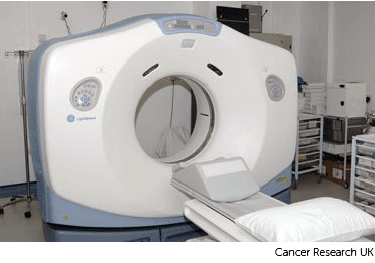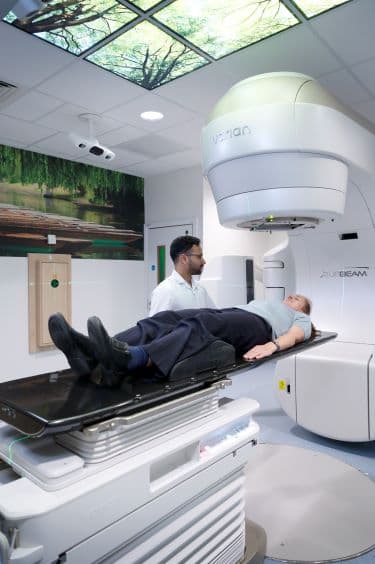Radiotherapy for anal cancer
Radiotherapy uses high energy waves similar to x-rays to destroy cancer cells. It is one of the main treatments for anal cancer.
You might have radiotherapy:
combined with chemotherapy (chemoradiotherapy)
to relieve symptoms of anal cancer that has spread (advanced anal cancer)
Chemotherapy combined with radiotherapy is called chemoradiotherapy. It is the main treatment for anal cancer that hasn't spread to other parts of the body.
Doctors know from research that this is a better treatment for anal cancer than surgery. If chemoradiotherapy is successful, you won't need a large operation and a .
You usually have radiotherapy for 5 days a week over 5 and a half weeks.
If you are not well enough to have the chemotherapy, you may have radiotherapy on its own. This is to control the cancer and reduce symptoms.
Read more about chemoradiotherapy for anal cancer
Radiotherapy can relieve the symptoms of advanced anal cancer, such as pain. It aims to shrink or control the growth of the cancer for a period of time. This is called palliative radiotherapy. It might help you to live longer and be more comfortable even if you cannot be cured.
How often you have radiotherapy depends on what symptoms you have and which part of the body you are having the treatment to.
Find out more about palliative radiotherapy
You normally have a type of external radiotherapy called intensity-modulated radiotherapy (IMRT) for anal cancer. External radiotherapy means the high energy waves are aimed at the cancer from outside the body.
IMRT is a type of conformal radiotherapy. Conformal radiotherapy shapes the radiation beams to closely fit the area of cancer.
You might have other types of radiotherapy to treat anal cancer that has spread elsewhere in the body.
You are usually given an information leaflet a few weeks before your planning appointment. This explains how to prepare your bladder and bowel for the planning CT scan and your treatment. Following this advice can help reduce long term side effects to your bladder and bowels.
Your radiographer will also explain how to prepare your bladder and bowels. They check you have emptied your bowels and ask you to empty your bladder before:
your CT scan
each radiotherapy treatment
They will then explain how to fill your bladder again by drinking water.
The radiotherapy team plans your radiotherapy before you start treatment. They do this during a planning appointment. This usually takes from 15 minutes to 2 hours.
Before your planning starts, your radiographer asks you to sign a consent form. If you can get pregnant, they will check that you are not pregnant already and remind you not to get pregnant during treatment. This is because radiation can damage an unborn baby.
You usually have a planning CT scan in the radiotherapy department.
The scan shows the cancer and the area around it. You might have other types of scans or x-rays to help your treatment team plan your radiotherapy. The plan they create is just for you.

Your radiographers tell you what is going to happen. They help you into position on the scan couch. You might have a type of firm cushion called a vacbag to help you keep still.
The CT scanner couch is the same type of bed that you lie on for your treatment sessions. You need to lie very still. Tell your radiographers if you aren't comfortable.
You might need an injection of contrast into a vein in your hand. This is a dye that helps body tissues show up more clearly on the scan.
Before you have the contrast, your radiographer asks you about any medical conditions or allergies. Some people are allergic to the contrast.
Sometimes you may have the contrast as a drink instead of into your vein.
Once you are in position your radiographers put some markers on your skin. They move the couch up and through the scanner. They then leave the room and the scan starts.
The scan takes about 5 minutes. You won't feel anything. Your radiographers can see and hear you from the CT control area where they operate the scanner.
The radiographers make pin point sized tattoo marks on your skin. They use these marks to line you up into the same position every day. The tattoos make sure they treat exactly the same area for all of your treatments. They may also draw marks around the tattoos with a permanent ink pen, so that they are clear to see when the lights are low.

The radiotherapy staff tell you how to look after the markings. The pen marks might start to rub off in time, but the tattoos won’t. Tell your radiographer if that happens. Don't try to redraw them yourself.
You might have to wait a few days or up to 3 weeks before you start treatment.
During this time the and your radiotherapy doctor (clinical oncologist) decide the final details of your radiotherapy plan. They make sure that the area of the cancer will receive a high dose and nearby areas receive a low dose. This reduces the side effects you might get during and after treatment.
Radiotherapy machines are very big and could make you feel nervous when you see them for the first time. The machine might be fixed in one position. Or it might rotate around your body to give treatment from different directions. The machine doesn't touch you at any point.
Before your first treatment, your will explain what you will see and hear. In some departments, the treatment rooms have docks for you to plug in music players. So you can listen to your own music while you have treatment.

You need to lie very still. Your radiographers might take images (x-rays or scans) before your treatment. This is to make sure that you're in the right position. The machine makes whirring and beeping sounds. You won’t feel anything when you have the treatment.
Your radiographers can see and hear you on a CCTV screen in the next room. They can talk to you over an intercom. You can also talk to them through the intercom or raise your hand if you need to stop or if you're uncomfortable
This type of radiotherapy won't make you radioactive. It's safe to be around other people, including pregnant women and children.
Side effects of radiotherapy for anal cancer can include feeling tired, sore skin around the anus and groin or bladder irritation. You may also have loose, frequent poos (diarrhoea) or feel sick.
Read more about the side effects of radiotherapy
You might have to travel a long way each day for your radiotherapy. This depends on where your nearest cancer centre is. This can make you very tired, especially if you have side effects from the treatment.
You can ask your radiographers for an appointment time to suit you. They will do their best, but some departments might be very busy. Some radiotherapy departments are open from 7 am till 9 pm.
Car parking can be difficult at hospitals. Ask the radiotherapy staff if you are able to get free parking or discounted parking. They may be able to give you tips on free places to park nearby.
Hospital transport may be available if you have no other way to get to the hospital. But it might not always be at convenient times. It is usually for people who struggle to use public transport. Or who have any other illnesses or disabilities. You might need to arrange hospital transport yourself.
Some people are able to claim back a refund for healthcare travel costs. This is based on the type of appointment and whether you claim certain benefits. Ask the radiotherapy staff for more information about this and hospital transport.
Some hospitals have their own drivers and local charities might offer hospital transport. So do ask if any help is available in your area.
Last reviewed: 04 Jun 2025
Next review due: 04 Jun 2028
Anal cancer is when abnormal cells in the anus divide in an uncontrolled way. It can start in different parts of the anus and different types of cell.
The stage of anal cancer tells you how big it is and whether it has spread. The type tells you which type of cell the cancer started in.
The treatment you have depends on several factors. Most people with anal cancer have radiotherapy and chemotherapy combined (chemoradiotherapy).
Chemotherapy combined with radiotherapy is called chemoradiotherapy. It is the most common treatment for anal cancer that hasn't spread to other parts of your body.
If you have anal cancer, there can be practical and emotional changes you may need help and support to cope with.
Anal cancer is cancer that starts in the anus. The anus is also called the anal canal.

About Cancer generously supported by Dangoor Education since 2010. Learn more about Dangoor Education
Search our clinical trials database for all cancer trials and studies recruiting in the UK.
Meet and chat to other cancer people affected by cancer.
Questions about cancer? Call freephone 0808 800 40 40 from 9 to 5 - Monday to Friday. Alternatively, you can email us.